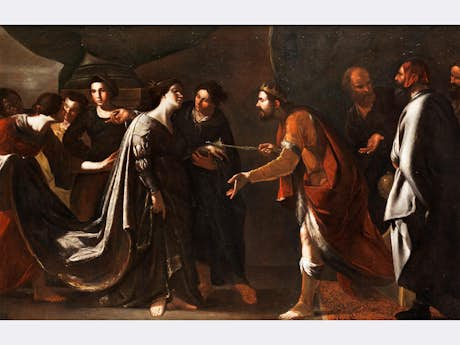Ricerca Bernardo Cavallino nell’asta
Dipinti Antichi Parte I
giovedì, 5 dicembre 2019
» rimettere
Il Vostro Art Agent personale

Siete interessati alle opere di Bernardo Cavallino?
Volentieri Vi teniamo aggiornati, quando le opere di Bernardo Cavallino verranno offerte in una delle nostre prossime aste.
Vi preghiamo di accettare la nostra politica sulla privacy
396
Bernardo Cavallino,
1616/22 Neapel – 1654/56 ebenda
ESTER VOR KÖNIG AHASVEROS Öl auf Leinwand.
98 x 151 cm.
Prezzo del catalogo € 70.000 - 100.000
Prezzo del catalogo€ 70.000 - 100.000
$ 75,600 - 108,000
£ 63,000 - 90,000
元 547,400 - 782,000
₽ 6,964,300 - 9,949,000
Der Künstler, über den lange nur wenig bekannt war, wurde erst durch die nachfolgend zitierte Publikation von Nicola Spinosa wieder ins Licht gerückt. Man vermutet, dass er möglicherweise Schüler von lokalen Malern wie Massimo Stanzione (1585-1656) war, jedenfalls von Michelangelo Merisi Caravaggio (1570/71-1610) und dessen Hell-Dunkel-Malerei stark beeinflusst. Auch dass er in der Eleganz seiner Bilddarstellungen von Anthony van Dyck (1599-1641) beeinflusst war, lässt sich im vorliegenden Bild deutlich erkennen. Ein gleichthematisches Werk seiner Hand findet sich in den Uffizien in Florenz, dort allerdings wohl noch in hellerer, noch nicht caravaggesker Farbgebung. Die Darstellung geht auf das biblische Buch Ester zurück, wo in Kapitel 5 die jüdische Nichte des Mordechai dem persischen König Ahasveros begegnet, der sie, der Legende gemäß, ehelichte und das jüdische Volk von Drangsal befreite. Die Szene ist mehrfigurig dargestellt: Die Hauptgestalten, Ester und der König, im Mittelgrund, wobei der König der jungen Frau das Zepter entgegenhält, während ihr Gesicht die Klage über ihr Volk zum Ausdruck bringt. Im Hintergrund seitlich weitere, die Szene begleitende Figuren. Die Farbstimmung lässt sich durchaus vergleichen mit einem weiteren Werk Cavallinos „Martyrium des Heiligen Stephan“ im Prado Museum, Madrid oder „Herkules und Omphale“, um 1640 (National Museum of Western Art, Japan).
Literatur:
Die Gemäldedarstellung ist besprochen und abgebildet in der genannten Publikation:
Nicola Spinosa, Grazia e tenerezza in posa – Bernardo Cavallino e il suo tempo (1616-1656), Edizioni per la Storia dell’Arte, Rom 2014 , S. 288-289, Nr. 24, dort eine gleichgestaltete Version in kleineren Leinwandmaßen (76 x 102 cm). (1211984) (5) (11)
Bernardo Cavallino,
1616 Naples – 1656 ibid.
ESTER BEFOrE KING AHASUERUSOil on canvas.
98 x 151 cm.
For a long time, not much was known about this artist, not until the below mentioned publication by Nicola Spinosa brought him back to the fore. It is assumed that he was possibly a student of local painters such as Massimo Stanzione (1585 - 1656), and he was greatly influenced by Michelangelo Merisi Caravaggio (1570/71 - 1610). Furthermore it is clearly visible in the painting on offer for sale here that he was influenced by Anthony van Dyck (1599 - 1641) with regards to the elegance of his picture presentation. A painting of the same subject painted by him is held at the Uffizi Gallery in Florence, but with a brighter colour scheme, which is not yet in the style of Caravaggio. The colour atmosphere is by all means comparable with other works by Cavallino such as Martyrdom of Saint Stephen held at the Prado Museum, Madrid or Hercules and Omphale, ca. 1640 (National Museum of Western Art, Japan).
Literature:
The depiction of the painting is discussed and illustrated in the following publication:
N. Spinosa, Grazia e tenerezza in posa - Bernardo Cavallino e il suo tempo (1616-1656), Edizioni per la Storia dell‘Arte, Rome 2014, pp. 288-289, no. 24, here a similar version with smaller canvas dimensions (76 x 102 cm).
This object has been individually compared to the information in the Art Loss Register data bank and is not registered there as stolen or missing.
Il Vostro Art Agent personale
Volete essere informati quando nelle nostre prossime aste un’opera di Bernardo Cavallino viene offerta? Attivate qui il Vostro Art Agent personale.
Vi preghiamo di accettare la nostra politica sulla privacy
Volete comprare un′opera di Bernardo Cavallino?
Il Vostro Art Agent Comprare in Private Sale Date delle aste
I nostri esperti sono felici di assistervi personalmente nella Vostra ricerca di opere d′arte
Volete vendere un′opera di Bernardo Cavallino?
Consegnate ora Vendita privata FAQ
Le vostre consegne sono sempre benvenute. Il nostro team sarà felice di assistervi personalmente in ogni fase trattative. Aspettiamo le vostre chiamate.
Contattate i nostri esperti







